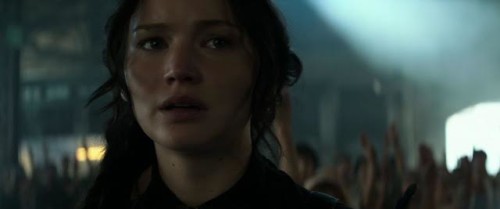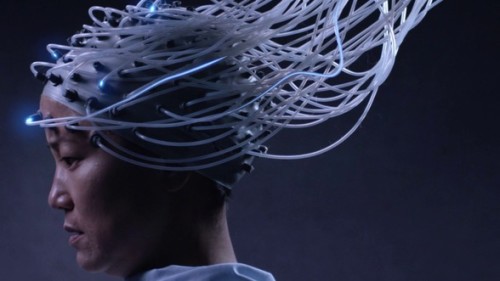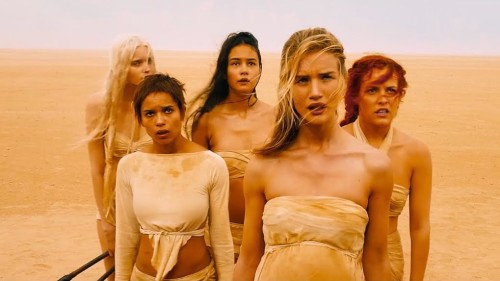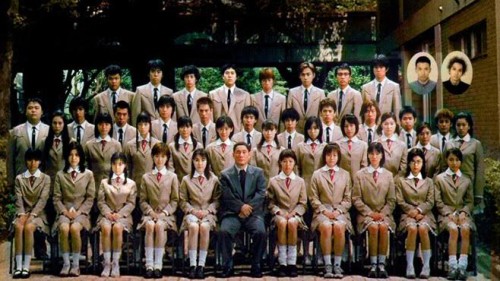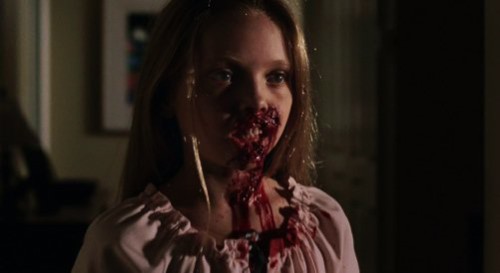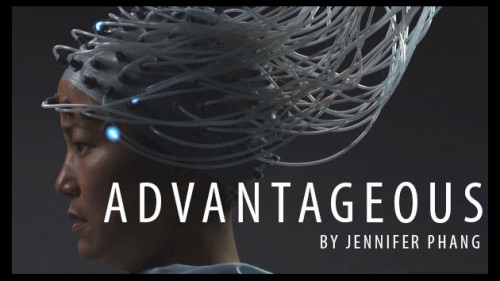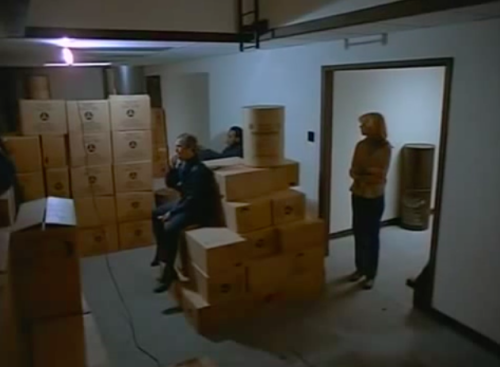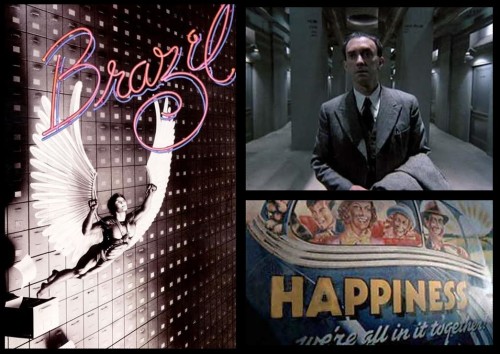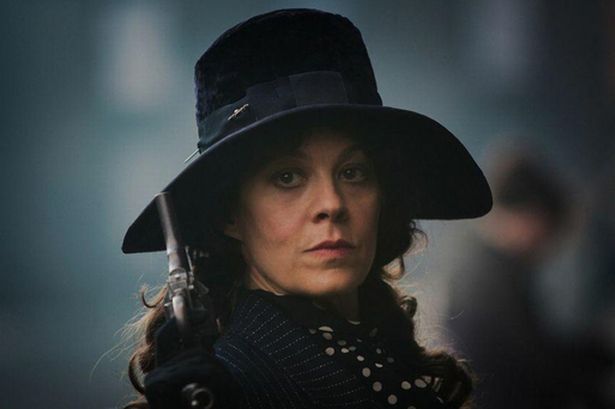This guest post by Charlotte Orzel appears as part of our theme week on Dystopias.
Mockingjay: Part One, the latest instalment of the massively popular Hunger Games series, begins with a terrified Katniss Everdeen huddled in a corner, muttering frantically to herself in a tearful fit, before being dragged off and sedated. Even for a series whose subject matter is children killing each other for sport, from its opening moments the film presents itself as noticeably darker than its predecessors. Director Francis Lawrence paints a grim portrait as the film explores the consequences wrought by the earlier events of the series, touching on torture, the large-scale destruction of warfare, violent suppression of insurrection, the mechanics of war propaganda, and the trauma the series’ violence has inflicted on its characters. But Mockingjay’s dark trappings mask the way the film foregrounds Katniss’ desperate romantic plight at the expense of both other aspects of her character and coherent dystopian critique. In doing so, Lawrence spins the illusion of a gritty, realistic criticism of war and propaganda headed by an independent, emotionally complex female character without truly providing the substance of either.
In Mockingjay, Katniss is at the centre of a political maelstrom, being urged by District Thirteen, the military leaders of the rebellion, to help create the propaganda material it needs to incite a revolution against the totalitarian Capitol. Katniss is suffering from PTSD and distraught about the capture of Peeta Mellark, her partner and love interest from two previous rounds in the Hunger Games. But when Peeta is forced to broadcast his demands for a ceasefire by the Capitol, Katniss concedes to take on the role of the revolution’s figurehead to ensure his immunity should the rebels win. Desperate to protect him from harm, Katniss must negotiate both District Thirteen’s subtle machinations and the violent retaliation of President Snow as she becomes entangled in the representational politics of a national war.
This is a significant departure from the way these events play out in the source material. In the first half of the novel, Katniss makes several decisions that within Lawrence’s film, are influenced or made for her by the rebel government and her handlers. For instance, the novel opens on Katniss having chosen to return to return to her firebombed home district against the wishes of President Coin’s strategy team. What she witnesses there causes her to react passionately against Peeta’s coerced call for a ceasefire and willingly adopt the role of Mockingjay. She does this not to ensure Peeta’s immunity, but to do what she can to strike back against the President Snow’s regime after the violent Capitol oppression she has witnessed and experienced. After witnessing a strike on the hospital in District Eight, it is Katniss who actively seeks out the cameras to make a speech to inflame the districts against President Snow’s regime. In the film, these events are reframed as ideas conceived by the rebels and their propaganda machine to maneuver Katniss into furthering their cause. Though we get a sense of District Thirteen’s manipulations in the novel, Katniss savvily negotiates with them, resists their orders, and remains distrustful of their motivations, in contrast to her comparatively slight unease in the film. While these changes leave most of the major plot elements intact, they undermine our sense of Katniss as an intelligent political actor who is connected to and moved by the revolution itself, rather than just her personal stake in the events.
But the most important difference from the novel is the absence of Katniss’ voice from Mockingjay. The novel, told in first-person, gives the reader a clear sense of Katniss’ desires and emotional state. Both verbally and cinematically, the film often fails to articulate her feelings about the proceedings, outside a sense of generalized trauma, vague unease about District Thirteen and her mounting concern for Peeta’s well-being. Part of this problem is the reduced role played by Gale Hawthorne, who is not only a love interest to Katniss, but her best friend since childhood. In earlier films and the novels especially, Gale’s function as a character is not only to create romantic conflict, but to also advocate for the necessity of the revolution and articulate the violence enacted by the Capitol, including how it extends beyond the Games to the oppression of the districts. By cutting down his role and changing the content of his conversations with Katniss into arguments about Peeta, Mockingjay squanders a valuable opportunity to allow Katniss to voice her perspective on the political environment she finds herself caught up in. It also seems to do so to up the romantic stakes at the expense of portraying a more nuanced relationship between these characters that includes but is not limited to romantic love. Without allowing Katniss to express her viewpoints on these broader issues, through her relationship with Gale or another character, the film feels directionless except in moments where Peeta’s safety is at risk.
Mockingjay appears to justify this shift in narrative purpose through Peeta’s capture itself. The choice to continuously orient Katniss’s decision-making around Peeta suggest that it is his capture that is the major source of her trauma, the trauma that pulls her attention continuously away from the political scene. As other reviewers have argued, it’s refreshing that Katniss is permitted to show emotionally vulnerability as the heroine of a major action film. But not only does much of Katniss’ trauma stem from issues unrelated to Peeta—growing up in the Capitol’s oppressive society where she lived on the edge of starvation; being subjected to violence and forced to perpetrate it within the Games; witnessing the violent repression of resistance to the regime; the destruction of her home district—these traumatic events are precisely the reasons she should be (and in the book, is) compelled to fight back against the Capitol. It would be remiss not to mention that these aspects of her history and the film’s political themes would have also have benefitted by portraying Katniss as a woman of colour, as she is strongly implied to be in the novels. In this volume of the series, doing so would have drawn our attention to the powerful social and psychological effects of racism, and the way its violences intertwine with capitalism. This choice would have also given more potent, layered meaning to Katniss’ newfound position as the “face of the revolution.” Ignoring these important elements of Katniss’ experience and the way they affect her decisions diminishes the particularity of her pain and the complexity of her character. And framing the progression of events in this way suggests that even if we do see more political action from Katniss in the next film, it will be incited by Peeta’s victimization by the Capitol and not her own experiences of oppression and violence.
To a certain degree, Katniss is also incapacitated by Peeta’s capture in the novel. The key difference, however, is that Katniss’ mounting fears about Peeta’s torture lead to a direct conflict between her personal and political goals: any action she takes to spur on the revolution will be met with physical harm to the boy she has grown to love. This internal struggle makes Katniss feel like a whole person with a range of concerns, but it also generates the kind of narrative momentum that drives effective stories.
Making Peeta’s capture and rescue Mockingjay‘s central concern also considerably deflates the film’s dystopian themes. Mockingjay purports to have something interesting to say about capital, war, propaganda, and trauma, but without Katniss’ perspective on these issues to anchor us, they lack both nuance and coherence. Lawrence draws parallels between the propaganda produced by District Thirteen and the spectacle of the Hunger Games, but while this gives us a broad sense that we should distrust President Coin and understand that war propaganda is bad, it fails to articulate this connection in a meaningful way. The film treats Katniss’ trauma as a cue that the film is dark and serious, while simultaneously using it as an excuse for avoiding a clear stance on its political issues. Unfortunately, these problems prefigure similar issues in the final half of Collins’ book that will likely make their way onscreen in the next film.
The problem with Katniss’ detachment from the political action becomes most acute in the last portion of the film, when the rebels launch a risky mission to rescue Peeta from the Capitol. In an effort to distract the Capitol forces, Katniss speaks directly to President Snow via video feed, telling him she never asked to be in the Games or become the Mockingjay, and that she only wanted to save her sister and Peeta. She begs him to release Peeta, offering to give up her role as figurehead and disappear. Then, conceding that he’s won, she pleads to let her exchange herself for Peeta. These statements seem like fundamental betrayals of the struggle Katniss has been growing into throughout the series, but film makes Katniss’ sincerity disturbingly unclear, especially in light of the ambiguity of her political stance earlier in the film. Is she just telling Snow what she believes he wants to hear, or is she truly so desperate to save Peeta that she will sacrifice the revolution itself for his safety?
No matter which is the case, Snow’s answer – “It’s the things we love most that destroy us.” – comes across as an interpretation of the outcome of Katniss’ efforts that, strangely, the film seems to validate. Pushed by Capitol torture into a distorted reality where Katniss is a dangerous enemy, the star-crossed lovers’ reunion results in an extended, disturbing sequence where Peeta wrestles Katniss to the ground, violently choking her. She escapes the encounter, and in a final sequence, watches him in a psychiatric ward, her reflection imposed over his thrashing body on the glass that separates them, as President Coin announces the successful outcome of the rescue at a political rally. This final, ghostly image of Katniss’ tortured face is a far cry from the expression of defiance that closed Catching Fire.
This sequence might have played differently had Katniss’ efforts to protect Peeta been only part of her focus in Mockingjay: Part One, or if this plot point had only been the midpoint of an adaptation of the entire novel. But as an ending, even to a film that promises a sequel, it seems bizarrely punitive and, frankly, horrifying. The film has spent two hours leading its audience alongside Katniss as she gives all her energy to Peeta’s rescue, only to tell both her and us that not only have her efforts been useless, but her loving sacrifices have only served to weaken her against her enemies. Of course, part of the rationale for this is to set up challenges for Katniss and Peeta to overcome in the next instalment. But the film should be able to offer a narrative experience that stands on its own and can thematically justify its existence, particularly if we’re meant to pay upwards of twelve dollars to see it. Obviously, we are not supposed to agree completely with President Snow, who is essentially the embodiment of pure evil in the film’s universe. But the story’s mixed messages offer us little alternative to conceding his victory.
The success of The Hunger Games’ franchise and its dystopian imitators such as the Divergent series or the CW’s The 100 seems to suggest that Hollywood is catching on to the idea that young audiences are willing to pay to see complex female leads and meatier social criticism. Mockingjay’s marketing implores us to embrace it as a gritty critique of oppression, propaganda, and war, and a feminist blockbuster led by a powerful teenage girl with more on her mind than romance (think about both propaganda-inspired posters and Jennifer Lawrence’s press tour pullquotes about how Katniss has too much on her plate to worry about who her boyfriend is). The problem with Mockingjay is not that either Katniss’ trauma or her love interest make her an uninteresting or weak female character. It’s that the film hypocritically champions its own success as female-driven, serious social critique, while in reality treating both these aspects with little depth or care.
As Mockingjay: Part Two looms on the horizon, we should remember that Hollywood’s willingness to deliver stories packaged to appeal to certain kinds of social consciousness does not mean filmmakers will engage beyond a surface level with the issues they use to sell their films. Teenage girls, as much as any audience, deserve complicated female characters, coherent and responsible social criticism, and well-crafted narratives in their media. As critical-minded viewers, we need to continue to demand and support substantive stories within and outside mainstream Hollywood and continue to identify those movies that only lay trendy glosses over empty promises.
Charlotte Orzel will take KA Applegate over Suzanne Collins any day of the week. Her interests include YA war stories, film exhibition, marriage dramas, and making fun of True Detective. She is a Master’s student in Media Studies at Concordia University in Montreal and tweets about life and film at @histoirienne.
